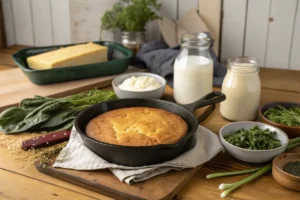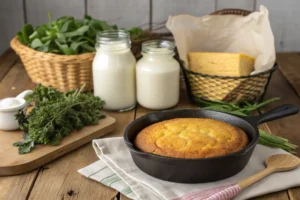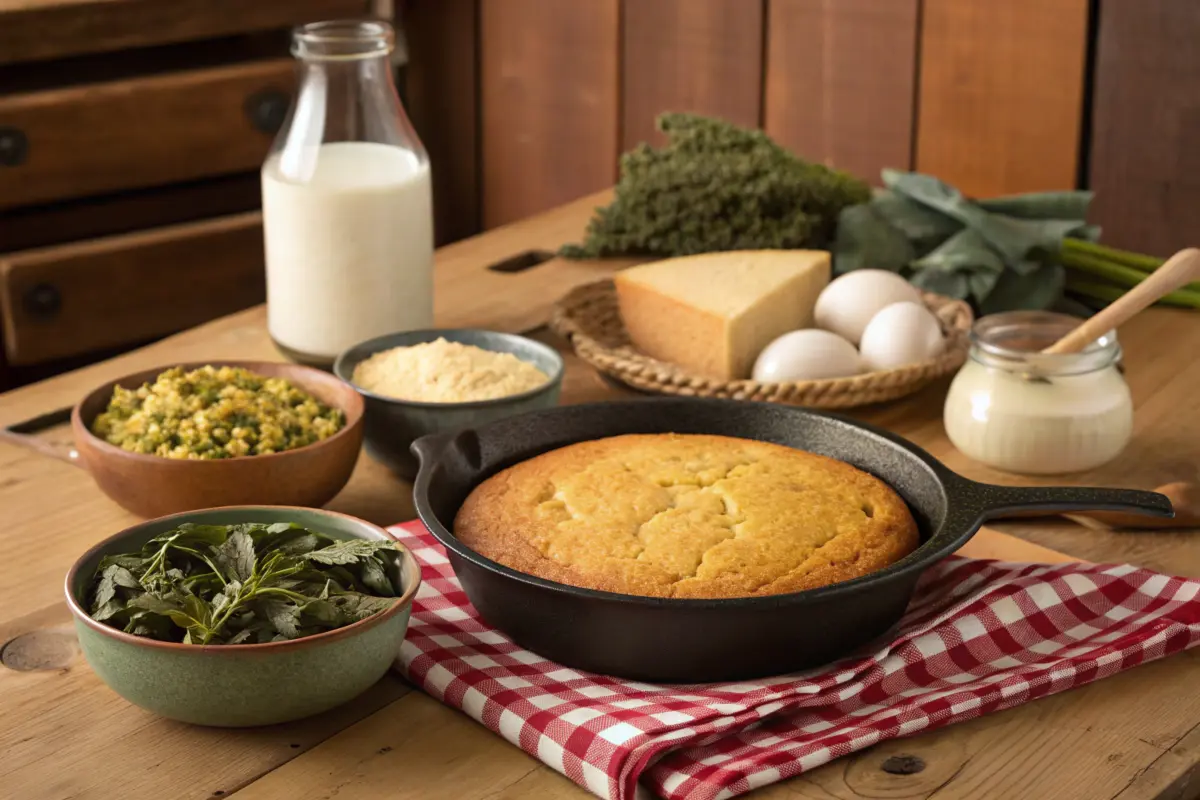Cornbread is a cornerstone of Southern cuisine, cherished for its simplicity and versatility. However, a question that often arises is, “Why do Southerners not put sugar in cornbread?” The answer lies in tradition, history, and a dedication to preserving the natural flavors of its core ingredients. While the debate between sweet and savory cornbread continues to divide opinions, the Southern approach remains firmly rooted in authenticity and practicality. This article explores the cultural and historical reasons behind this iconic dish, its role in Southern identity, and how it has evolved over time.
Let’s begin with the historical roots of cornbread in Southern cuisine.
The Historical Roots of Cornbread in Southern Cuisine
The Evolution of Cornbread Through Time
Southern cornbread, a savory and rustic dish, has deep roots in history, shaped by the agricultural and economic realities of the American South. To truly understand why Southerners do not put sugar in cornbread, it’s essential to explore how this culinary tradition developed and became a cultural staple.
Cornbread originated from Native American cooking, where corn (or maize) was a fundamental ingredient. Early settlers in the South adopted and adapted Native American recipes, using locally grown dent corn to create a bread that was simple yet versatile. Unlike flint corn, which was common in the North and naturally sweeter, dent corn had a robust, earthy flavor that required no sugar to mask or enhance its taste.
Historically, the South faced significant economic challenges, from the agricultural hardships of the antebellum era to the widespread poverty during Reconstruction and beyond. Sugar, at the time, was expensive and often unavailable to many Southern households. As a result, cornbread recipes were intentionally minimalist, relying on just a few ingredients: cornmeal, water, and salt. This simplicity allowed Southern families to stretch their resources while still enjoying a hearty and satisfying meal.

Economic and Agricultural Influences
The South’s agricultural landscape also played a crucial role in shaping its cornbread traditions. Farmers grew dent corn, a variety with a rich, earthy flavor but less natural sweetness compared to flint corn, which was more common in the North. This meant that Southern cooks didn’t need to mask the corn’s flavor with sugar.
During the 19th and early 20th centuries, the South faced economic hardships, and ingredients like sugar were considered luxuries. Cornbread was a poor man’s bread, often made without flour, eggs, or milk, let alone sugar. Its simplicity wasn’t just about taste—it was a reflection of the region’s resilience and resourcefulness.
Conclusion
Cornbread’s historical roots in the South showcase why it has always been a savory staple. Its evolution and reliance on locally available ingredients highlight how practicality and tradition have influenced its flavor profile. In the next section, we’ll dive into the cultural and culinary differences that fuel the sweet vs. savory cornbread debate.
The Debate: Sweet vs. Savory Cornbread
Cultural Differences Between Northern and Southern Cornbread
The divide between Northern and Southern cornbread isn’t just about taste; it’s a cultural clash that highlights regional preferences and traditions. Northern cornbread tends to be sweeter, lighter, and more cake-like. This reflects the abundance of sweeter corn varieties, like flint corn, which early Northern cooks used to make their meals. To enhance the natural sweetness of their cornmeal, they added sugar or molasses, resulting in a bread with a distinctly sweet flavor.
Southern cornbread, on the other hand, is entirely different. It’s known for its dense texture, golden crust, and savory, earthy flavor. The focus is on the natural taste of the cornmeal, with ingredients like buttermilk and bacon drippings adding depth. The absence of sugar in Southern cornbread isn’t an oversight; it’s a deliberate choice that reflects a culinary philosophy centered on simplicity and authenticity.
This difference between sweet and savory cornbread has sparked countless debates, with each side claiming superiority. However, it ultimately boils down to personal preference and the food traditions of each region.
Why Sugar Is a Northern Preference
So, why do Southerners avoid sugar in their cornbread while Northerners embrace it? Geography and history provide the answers. Flint corn, a sweeter variety, grew well in the cooler climates of the North. Naturally, Northern cooks leaned into its sweetness, using sugar to amplify the flavor further. Additionally, the influence of European settlers, who often used sweeteners in their bread recipes, shaped the Northern style of cornbread.
Meanwhile, in the South, dent corn dominated the fields. This type of corn produced meal with a rich but less sugary taste. Southern cooks aimed to complement the savory notes of their dishes, like collard greens and beans, rather than competing with them. Adding sugar to cornbread would disrupt this delicate balance, which is why it’s largely avoided to this day.
To delve deeper into the ongoing cornbread debate, check out this detailed comparison of Northern and Southern cornbread traditions.
Southern Culinary Philosophy and Cornbread
Savory Cornbread as a Reflection of Southern Taste
Southern cuisine has always prioritized bold, natural flavors over embellishments. Cornbread is no exception. The dish serves as a foundation for countless meals, providing a neutral but flavorful base for rich, savory staples like gumbo, chili, and fried catfish. Sweetening the bread would detract from its versatility, making it less adaptable to Southern dishes.
Moreover, Southern cooks believe in letting the ingredients shine. In traditional recipes, cornmeal takes center stage, with buttermilk and eggs playing supporting roles. The result? A bread that tastes like pure, unadulterated corn, accented by the tanginess of buttermilk.
The Practical Side of Omission
Leaving sugar out of cornbread isn’t just a matter of taste; it’s also practical. Historically, sugar was a luxury item in the South, especially during times of economic hardship. Even when it became more accessible, many families stuck to the old ways of making cornbread because it paired better with their meals. For instance, the savory profile of traditional Southern cornbread complements bitter greens, creamy beans, and smoked meats perfectly.
In fact, adding sugar might make the bread overly sweet, clashing with these dishes. By omitting sugar, Southern cooks ensure their cornbread remains a versatile, complementary side dish. For a deeper dive into the history of this iconic dish, check out this insightful piece on Southern cornbread traditions.

Controversy and Modern Adaptations
The Divided Opinion Among Southerners Today
Even in the South, opinions on cornbread are evolving. While traditionalists firmly believe that sugar has no place in cornbread, modern interpretations often experiment with a touch of sweetness. This has sparked heated debates among food enthusiasts and chefs alike. Some argue that adding sugar doesn’t compromise tradition but simply modernizes it, while others feel it dilutes the authenticity of Southern cornbread.
Interestingly, younger generations in the South are more likely to embrace sweet cornbread, especially when paired with sweeter main dishes. However, many still see savory cornbread as a quintessential Southern food that needs no embellishments. Ultimately, whether sugar belongs in cornbread remains a deeply personal choice, but the debate keeps this humble dish in the spotlight.
Adaptations in Contemporary Recipes
Modern Southern cooks and bakers have found creative ways to bridge the gap between sweet and savory. Some recipes now include just a hint of sugar, while others experiment with honey or molasses for a natural sweetness. Other adaptations incorporate unique ingredients like jalapeños, cheese, or even bacon to enhance the savory flavor.
For those looking for a traditional Southern cornbread recipe, check out this helpful guide: Difference Between Cornbread and Southern Cornbread. It offers a deeper look into how Southern cornbread stands apart from its Northern counterpart.
Regional Pride and Cornbread Traditions
Cornbread as a Symbol of Southern Identity
In the South, cornbread is more than food—it’s a cultural icon. This simple dish embodies the region’s history, resourcefulness, and commitment to local flavors. Why do Southerners not put sugar in cornbread? The answer often lies in this unwavering sense of identity. For many, sticking to a savory recipe is about honoring their roots and preserving a tradition that connects them to previous generations.
Additionally, cornbread serves as a unifying dish at Southern gatherings, from church potlucks to family dinners. Its versatility ensures it complements a wide range of meals, cementing its place as a Southern staple.
Preserving Tradition in a Changing Culinary Landscape
As the world of food evolves, maintaining authenticity becomes even more important. Southern chefs and home cooks alike continue to champion the traditional recipe, ensuring that it remains a cornerstone of their cuisine. Even as modern variations gain popularity, the savory cornbread tradition stays alive, proving that some things never go out of style.
For more delicious recipes rooted in tradition, explore other options on Mrs. Recipes Chef. The site offers a variety of comforting and nostalgic recipes to try at home.
FAQs on Southern Cornbread
Why Do Southerners Not Put Sugar in Cornbread?
This is a question that has sparked curiosity far beyond the South. The simple answer is that traditional Southern cornbread was created to be a savory dish. Historically, sugar was a luxury in the South, and dent corn, the type of corn used in Southern recipes, had a rich, earthy flavor that didn’t need additional sweetness. Instead of altering the natural taste, Southerners embraced its simplicity, letting the cornmeal shine without sugar overshadowing its flavor.
Even today, this preference reflects a culinary tradition that values authenticity and practicality. While some modern cooks might sneak in a bit of sugar, many Southerners stick to the adage, “If it’s sweet, it’s cake not cornbread.”
Is Sugar Ever Acceptable in Southern Cornbread?
While it’s rare, there are situations where sugar might make an appearance in Southern kitchens. For instance, cooks preparing cornbread for desserts or sweeter side dishes might add a small amount to balance the flavors. However, for traditional meals like fried chicken or collard greens, savory cornbread remains the go-to choice.
If you’re looking to explore variations, try blending a touch of sweetness with savory elements like cheese or jalapeños for a modern twist. Just remember, true Southern purists might raise an eyebrow at the idea!
What Makes Southern Cornbread Different From Other Types?
Southern cornbread is all about its distinct texture and flavor. It’s denser and less fluffy than its Northern counterpart, with a crispy golden crust achieved by baking it in a cast iron skillet. The ingredients are minimal—cornmeal, buttermilk, eggs, and sometimes bacon drippings—but the result is anything but plain.
Unlike Northern cornbread, which often includes flour and sugar to make it sweeter and more cake-like, Southern cornbread is all about the corn. This minimalism allows it to complement hearty Southern dishes without competing for attention.
Final Thoughts and Summary
The Legacy of Cornbread in Southern Cooking
Cornbread’s journey from a humble necessity to a symbol of Southern pride is a testament to its importance in the region’s culinary history. Why do Southerners not put sugar in cornbread? The answer lies in their commitment to preserving tradition and celebrating the natural flavors of their ingredients. For Southerners, cornbread isn’t just a side dish—it’s a reminder of their heritage.
Embracing the Savory Tradition
Whether you’re a fan of the classic savory version or enjoy experimenting with modern adaptations, cornbread offers something for everyone. Its versatility and deep connection to Southern culture make it a dish worth savoring and sharing. If you’ve never tried authentic Southern cornbread, grab a skillet, skip the sugar, and experience a true taste of the South.
For more recipe inspiration and traditional dishes, explore Mrs. Recipes Chef. Dive into the heart of Southern cooking and discover how simple ingredients can create unforgettable flavors.

